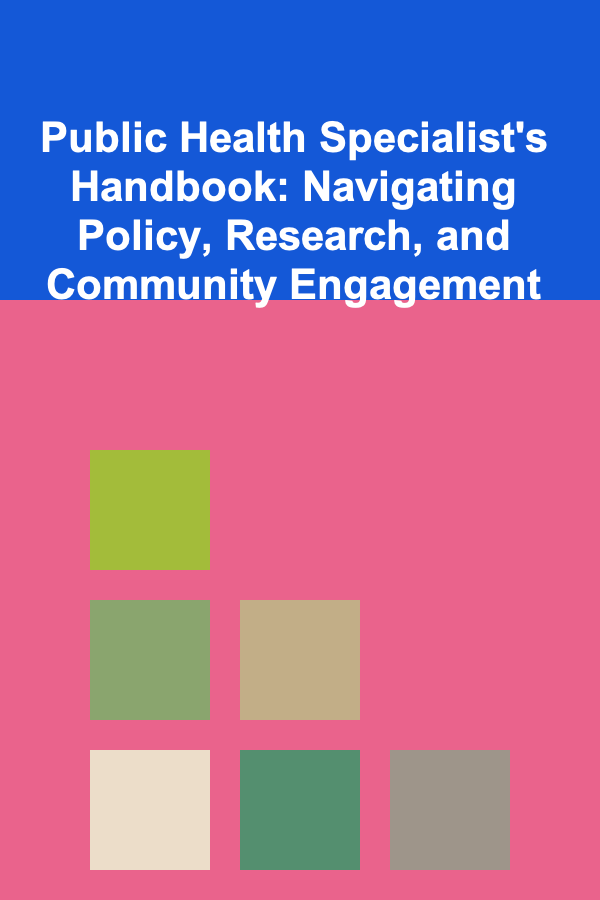
Public Health Specialist's Handbook: Navigating Policy, Research, and Community Engagement
ebook include PDF & Audio bundle (Micro Guide)
$12.99$10.99
Limited Time Offer! Order within the next:

Public health specialists play a vital role in shaping the health landscape of communities, countries, and even the world. Their work spans a broad spectrum, from developing and advocating for policies to conducting research and fostering community engagement. These specialists are the catalysts behind systemic changes that enhance health outcomes, prevent disease, and promote wellbeing. This guide serves as an actionable resource for navigating the complexities of public health, focusing on three key areas: policy, research, and community engagement.
Understanding Public Health Policy
Public health policy is the backbone of any health intervention or program. It involves decisions, plans, and actions undertaken by governments or organizations to promote and protect health at the population level. Crafting effective public health policies requires a deep understanding of the health challenges a community faces, evidence-based research, and the ability to work across different sectors of society.
Key Elements of Public Health Policy:
a. Policy Formulation and Development
Creating sound public health policies begins with identifying public health problems, understanding their causes, and defining goals for improvement. This requires collaboration among various stakeholders, including health professionals, policymakers, and the affected community.
- Evidence-based Research: Policies should be grounded in reliable data and scientific evidence. Use data from epidemiological studies, health surveys, and other health indicators to inform decisions.
- Stakeholder Involvement: Engage key stakeholders such as government agencies, healthcare providers, community leaders, and advocacy groups in the policy development process to ensure the policy is holistic and effective.
- Setting Clear Objectives: Define the outcomes expected from the policy. These could range from reducing smoking rates to improving maternal health or increasing access to clean water.
b. Policy Implementation
Once policies are developed, their successful implementation is crucial. This step involves resource allocation, defining roles and responsibilities, and ensuring that there is a clear plan to put the policy into action.
- Capacity Building: Public health specialists should ensure that the workforce is adequately trained and equipped to carry out the policy's objectives.
- Budgeting and Resources: Adequate funding is essential for successful implementation. The policy should be backed by sustainable financial support to ensure long-term impact.
- Monitoring and Evaluation: Establish a system to monitor the policy's progress and assess its impact. Continuous evaluation allows for adjustments and ensures the policy's effectiveness.
c. Advocacy and Communication
To be successful, public health policies often require the backing of the public, lawmakers, and key stakeholders. Public health specialists must be adept at advocacy and communication to garner support for policies.
- Public Awareness Campaigns: Use media and community outreach programs to raise awareness about the policy's benefits.
- Lobbying for Support: Work with lawmakers and governmental bodies to advocate for the resources needed to support the policy.
- Clear Messaging: Develop clear and compelling messages that explain why the policy is important for public health and how it will improve community health outcomes.
Actionable Tip:
Start by analyzing current public health issues in your community or country. Gather data, consult with experts, and build a coalition of stakeholders who share your vision for policy change. Begin with small pilot policies that can be scaled if successful.
Conducting Public Health Research
Research is the cornerstone of public health practice, providing the evidence necessary to guide policy decisions, interventions, and community health programs. Whether it's epidemiological studies, clinical trials, or qualitative research, public health research helps to identify health problems, determine causes, and test potential solutions.
Key Elements of Public Health Research:
a. Defining the Research Question
The first step in any research project is to define the problem clearly. A well-defined research question drives the study design, methodology, and data collection process. For example, a research question might be: "What are the primary factors contributing to childhood obesity in low-income communities?"
- Problem Identification: Identify pressing public health issues through data analysis, consultations with stakeholders, and community feedback.
- Objective Clarity: Set clear, measurable goals for your research. These should align with the overall public health objectives of improving outcomes, reducing inequalities, or preventing diseases.
b. Study Design and Methodology
Public health research can take various forms, such as descriptive studies, cohort studies, randomized controlled trials (RCTs), or qualitative research. Each has its strengths and weaknesses, and choosing the right methodology is crucial for obtaining reliable results.
- Quantitative vs. Qualitative Research: Quantitative methods (e.g., surveys, statistical analysis) are often used for large-scale studies where data needs to be generalized. Qualitative methods (e.g., interviews, focus groups) are useful for understanding complex behaviors and experiences.
- Sampling: Ensure that your sample size is representative of the population you're studying. A good sample will provide reliable data that can inform decision-making.
- Data Collection Tools: Choose tools that are valid, reliable, and culturally appropriate for your target population. This could include surveys, health assessments, or community-based participatory research methods.
c. Data Analysis and Interpretation
After collecting data, the next step is analyzing it to draw conclusions and make recommendations.
- Statistical Analysis: Use statistical software to process quantitative data. Interpret the results to understand correlations, trends, and patterns that relate to health issues.
- Qualitative Data Analysis: For qualitative research, analyze themes that emerge from interviews or focus groups. Tools like NVivo or Atlas.ti can assist in organizing and coding qualitative data.
- Ethical Considerations: Ensure that your research adheres to ethical standards, particularly in terms of participant confidentiality and informed consent.
d. Disseminating Findings
Once your research is complete, the next step is sharing your findings with relevant stakeholders, including policymakers, healthcare providers, and the community.
- Peer-Reviewed Journals: Publishing in reputable journals ensures that your research is validated by other experts in the field.
- Presentations and Reports: Use conferences, workshops, or community meetings to present your findings to policymakers, practitioners, and the general public.
- Policy Recommendations: Translate your findings into actionable policy recommendations that can address public health challenges.
Actionable Tip:
Collaborate with universities, research organizations, and health departments to conduct joint studies. Seek funding opportunities through grants or public health agencies to support your research projects.
Engaging Communities in Public Health
Community engagement is essential for achieving meaningful and sustainable improvements in public health. By involving the community in the planning and implementation of health interventions, public health specialists can create more effective, culturally sensitive, and locally supported programs.
Key Elements of Community Engagement:
a. Building Trust and Relationships
Establishing trust is the foundation of successful community engagement. Public health specialists need to build strong, lasting relationships with community leaders, organizations, and the residents themselves.
- Cultural Competence: Understand the cultural norms, values, and health beliefs of the community. Tailor your approach to ensure that interventions resonate with the community.
- Respect and Inclusion: Involve community members in the decision-making process. This fosters a sense of ownership and responsibility for the program's success.
- Partnerships: Collaborate with local community organizations, schools, faith groups, and healthcare providers. These partners can help facilitate communication and ensure that health programs meet local needs.
b. Participatory Health Promotion
Health promotion efforts are most effective when community members are actively involved. Public health specialists should focus on participatory methods that empower individuals to take charge of their health.
- Community Health Needs Assessments (CHNA): Engage the community in identifying local health problems through surveys, focus groups, or town hall meetings. Use this information to design relevant programs.
- Health Education: Offer programs that educate community members about healthy behaviors, disease prevention, and available health services. Utilize local leaders to promote these messages effectively.
- Training Community Health Workers: Train local individuals to become health advocates or workers who can help deliver health services, monitor health outcomes, and advocate for local issues.
c. Sustaining Community Engagement
Sustainability is key to the long-term success of community health programs. Public health specialists should ensure that the engagement is not just a one-time event but a continuous process that evolves based on community needs.
- Feedback Loops: Regularly gather feedback from the community about health programs and adjust strategies accordingly.
- Community Ownership: Encourage community ownership by involving them in the ongoing monitoring, evaluation, and adaptation of programs.
- Celebrating Successes: Publicly recognize community efforts and celebrate health improvements. This reinforces positive behavior and motivates continued engagement.
Actionable Tip:
Host regular community forums to keep residents informed about health initiatives. Create advisory boards consisting of community members to guide and inform program decisions. Make sure to adapt your strategies based on community feedback.
Conclusion
Navigating the complex landscape of public health requires a balanced approach involving policy formulation, research, and community engagement. Public health specialists play an essential role in advancing the health and well-being of populations by creating evidence-based policies, conducting rigorous research, and fostering strong community involvement. Each of these areas---policy, research, and community engagement---intersects, creating a comprehensive strategy to tackle public health challenges.
By continuously improving in these three core areas, public health specialists can ensure that their efforts are impactful, sustainable, and ultimately lead to healthier communities.
Reading More From Our Other Websites
- [Biking 101] Top 5 Single Speed Bikes for Simple and Efficient Cycling
- [Personal Investment 101] How to Build Wealth Using Dividend Stocks
- [Home Pet Care 101] How to Stop Your Cat from Scratching Furniture Without Harm
- [Digital Decluttering Tip 101] Best Approaches to Streamlining Password Managers for Family Use
- [Home Holiday Decoration 101] How to Add Holiday Cheer to Your Kitchen with Simple Touches
- [Organization Tip 101] How to Create a Family Recipe Binder for Meal Planning
- [Home Security 101] How to Install and Use a Home Security System with Professional Monitoring
- [Personal Care Tips 101] How to Achieve Long-Lasting Results with Teeth Whitening Strips
- [Whitewater Rafting Tip 101] Expert‑Only Runs: Tackling the Most Challenging Rivers Worldwide
- [Organization Tip 101] How Often Should You Replace Your HVAC Filter?

Customer Experience Manager's Handbook: Driving Success Through Customer-Centered Strategies
Read More
How to Use Email Marketing for Customer Retention: A Simple Checklist
Read More
How to Use Textures and Fabrics for a Cozy, Inviting Staged Home
Read More
How to Understand the Regulatory Landscape for EVs
Read More
How to Market Your Translation Services Online
Read More
10 Tips for Mastering Data Analysis for Digital Marketing Strategy
Read MoreOther Products

Customer Experience Manager's Handbook: Driving Success Through Customer-Centered Strategies
Read More
How to Use Email Marketing for Customer Retention: A Simple Checklist
Read More
How to Use Textures and Fabrics for a Cozy, Inviting Staged Home
Read More
How to Understand the Regulatory Landscape for EVs
Read More
How to Market Your Translation Services Online
Read More